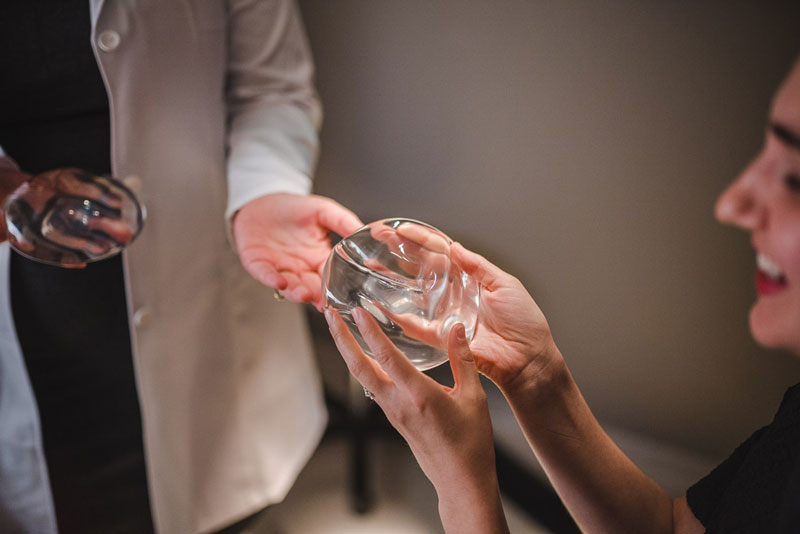Breast Augmentation
Breast augmentation, also called “augmentation mammaplasty,” is a procedure designed to enhance the size and improve the shape of a woman’s breasts. This procedure can add volume and restore more youthful contours to the breast.
Model
How do I know if a breast augmentation is right for me?
Women have many different reasons for choosing breast augmentation surgery, but most of them fall into one of these four categories:
Naturally Small Breasts
Women who have small or asymmetrical breasts can achieve enhanced volume and natural-looking results with breast augmentation.
Breast Revision
If a previous breast surgery was unsatisfactory or resulted in complications, a secondary breast augmentation can be performed to correct concerns in some cases.
Change in Breast Size After Pregnancy
Pregnancy and breastfeeding often lead to a reduced breast size and cause a deflated breast appearance. Breast augmentation can restore your original breast volume or enhance them to a larger size if desired.
Sagging Breasts
Aging, pregnancy, and significant weight loss can cause the breasts to sag and change shape. A breast augmentation (sometimes performed in combination with a breast lift) can improve the shape of the breasts and provide a more youthful appearance.

Silicone vs. Saline
Silicone Implants
- FDA-approved for women 22 years or older
- Pre-filled with silicone gel
- Lower rate of rupture than saline implants
- Feel more natural than saline implants
Saline Implants
- FDA-approved for women 18 years or older
- Filled with sterile saltwater solution after insertion
- If a rupture occurs, it will be noticeable immediately
- Size can be adjusted during surgery
The Breast Augmentation Process
Consultation
Once you fill out a consultation request, you will be contacted to confirm an appointment for a one-on-one consultation with Dr. Yonker. This appointment includes an analysis of your health history, any medications you are taking, and what you desire to achieve with the procedure. You should have all of this information with you when you come to your appointment. Dr. Yonker will discuss the techniques that will best provide you with the results you desire and answer any questions you may have.
Preoperative Instructions
Dr. Yonker will review all of the detailed information you need to know prior to surgery at your preoperative appointment. Generally, patients should avoid smoking and taking anti-inflammatory medication (e.g., aspirin and ibuprofen) for at least two weeks before surgery. Some vitamins and supplements may also cause problems during or after surgery, so it is best to avoid them or to talk to your surgeon about potential side effects. Be sure to arrange for someone to drive you home and care for you for the first 48 hours after your procedure.
During the Procedure
Breast augmentation is typically performed with general anesthesia and takes about two hours to complete. Based on the techniques agreed upon during your consultation, Dr. Yonker will place the implants either above or below the pectoral muscle. Incisions are most commonly made beneath the breasts at the crease and are closed with sutures.
Recovery
After surgery, you will likely be advised to wear a special bra garment to aid with swelling and to keep you comfortable. Swelling will typically subside after about three weeks but may last as long as a few months. For the first few days after surgery you will need to get plenty of rest and avoid bending, heavy lifting, or strenuous exercise. Most patients are able to return to work in one week and resume regular exercise after about six weeks. Your surgeon will give you more detailed information about what you can expect during your recovery.
Breast Augmentation FAQ
-
Who are the best candidates for breast augmentation?
The best candidates for breast augmentation wish to increase the size of their breasts. Most were either born with naturally small breasts or had deflation due to pregnancy, weight loss, or aging. Patients who have excessively sagging breasts may be better candidates for a breast lift or a breast lift in combination with an augmentation. Ideal patients are also in good physical health and do not smoke.
-
What type of implant should I choose?
There are many implant choices available. Options typically include the implant material (silicone or saline), size, shape, and profile of the implant. After consultation, Dr. Yonker will recommend the best implant for you based on your physical anatomy and your desires for the procedure.
-
Where are the incisions made?
The two most common incision locations are under the breast along the crease (inframammary) and around the nipple (periareolar). Dr. Yonker will discuss the pros and cons of each incision with you to help determine the best incision location for you.
-
How long will my breast implants last?
Breast implants are not considered lifetime devices and may need to be replaced at some point after the original surgery. On average, most women have their implants replaced between ten and fifteen years after they are first inserted.
-
What complications can occur?
As with any surgery, there is a risk of developing complications after breast augmentation. Although rare, the most common complication is called capsular contracture. Capsular contracture occurs when a “capsule” of scar tissue forms around the implant, becomes unusually hard, and contracts around the implant. This can lead to a change in appearance of the implant and in extreme cases can cause pain. Other complications of breast augmentation surgery include implant rupture, symmastia, double-bubble deformity, asymmetry, and implant rippling. Breast revision surgery can potentially correct these complications if they occur.
-
Is there scarring with breast augmentation?
Incisions are placed in locations that are as inconspicuous as possible, and the resulting scars will fade significantly over time. Protecting your scars from the sun will help prevent them from darkening.
Model